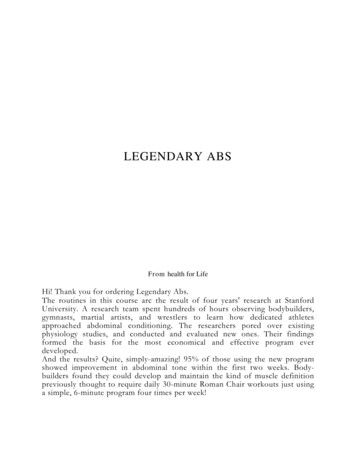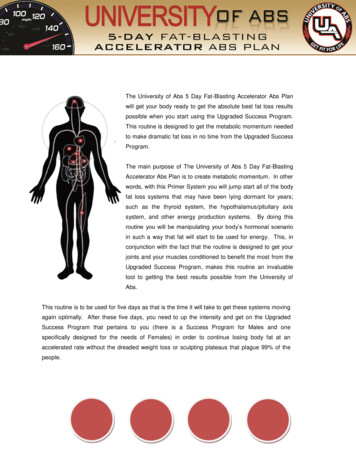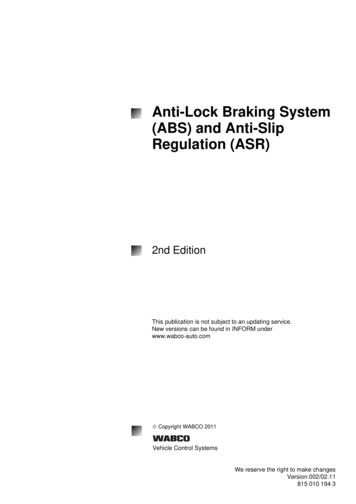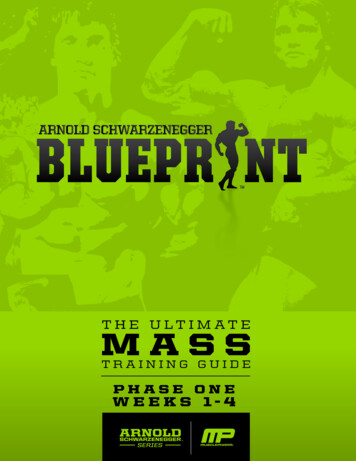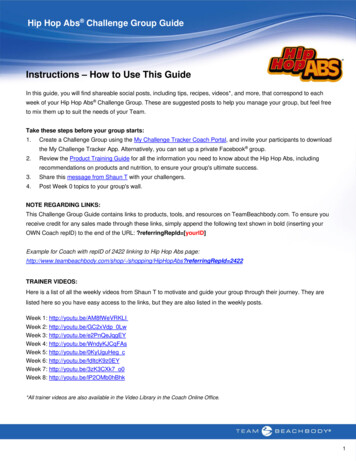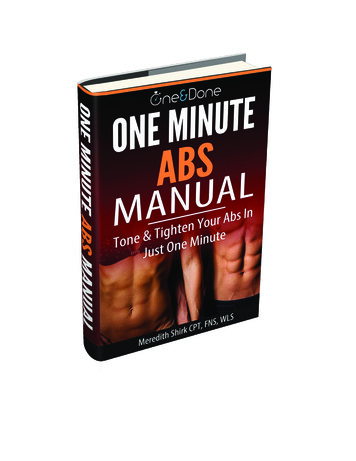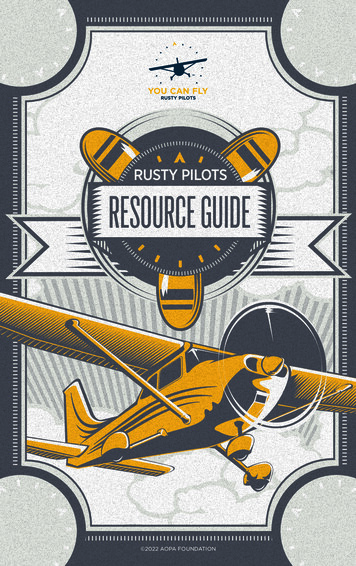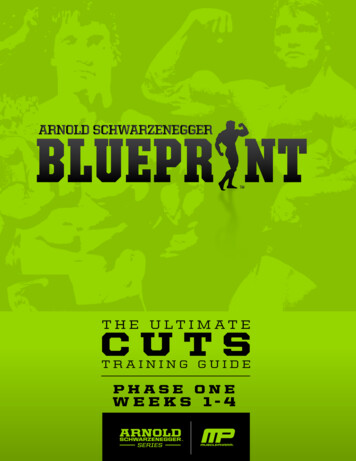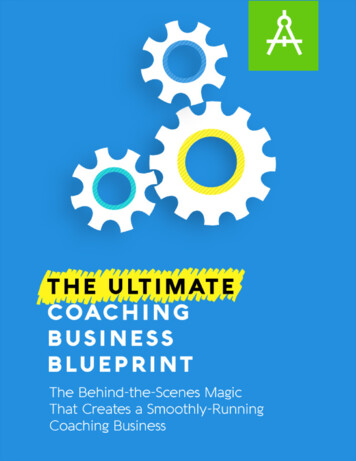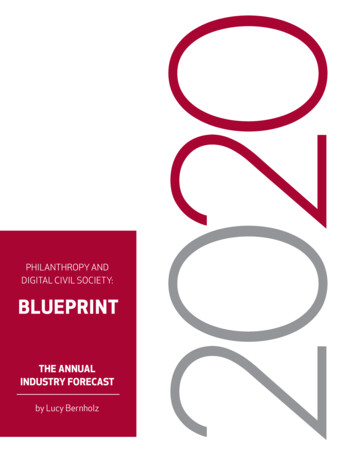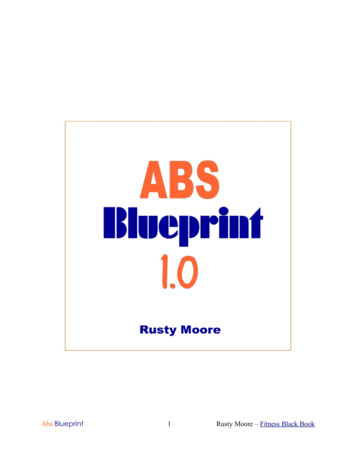
Transcription
Abs Blueprint1Rusty Moore – Fitness Black Book
Copyright NoticeNo part of this report may be reproduced or transmitted in any form whatsoever,electronic, or mechanical, including photocopying, recording, or by anyinformational storage or retrieval system without expressed written, dated andsigned permission from the author. All copyrights are reserved.Disclaimer and/or Legal NoticesThe information provided in this book is for educational purposes only. I am not adoctor and this is not meant to be taken as medical advice. The informationprovided in this book is based upon my experiences as well as my interpretationsof the current research available.The advice and tips given in this course are meant for healthy adults only. Youshould consult your physician to insure the tips given in this course are appropriatefor your individual circumstances.If you have any health issues or pre-existing conditions, please consult with yourphysician before implementing any of the information provided in this course.This product is for informational purposes only and the author does not accept anyresponsibilities for any liabilities or damages, real or perceived, resulting from theuse of this information.Abs Blueprint2Rusty Moore – Fitness Black Book
Table of ContentsIntroduction: Why So Few People Have 6 Packs Abs.What 23 years in the gym has taught me about what it takesto have head turning abs.and why so few ever get there.5 -----------Part 1 - The Exercises---------- Chapter 01: An Introduction to Leg RaisesI will explain why I'm convinced that working the absusing your legs as resistance is the best approach to take.8Chapter 02: Lying Leg RaisesAlthough many consider this to be a beginner exercise, Iwill show you why it works the lower abs especially well.10Chapter 03: Hanging Leg RaisesHow to slowly work up from hanging knee ups, all theway to more advanced versions of hanging leg raises.12Chapter 04: PlanksThe perfect ab exercise to ensure even ab development fromtop to bottom as well as reinforce good posture.16Chapter 05: The Ab WheelA harder stabilization exercise than the plank. Effectiveif done right, damaging if done wrong!20Chapter 06: Renegade RowsThis exercise tightens the heck out of your obliques andthe muscles that “frame” your abs.22Abs Blueprint3Rusty Moore – Fitness Black Book
Chapter 07: Hip Bridges and Back BridgesWhy you should include bridging after every ab workout.This is crucial for spine health.24 ----------Part 2 - The Workout Variables---------- Chapter 08: Low Velocity vs High Velocity TrainingWhen to use slow reps, when to speed up the tempo, andwhen to use explosive reps to increase tension.27Chapter 09: Low Reps vs High RepsWhen it makes sense to use high reps for an ab exerciseand when it makes sense to use low reps.28Chapter 10: The Ab Development Blueprints6 specific routines that work especially well for gettinga tight and defined midsection.30Chapter 11: Working Around a Back InjuryHow to work your abs with an injured back. Whatexercises to avoid at all costs.40Chapter 12: Great Abs for LifeWhat you will need to do to improve as you age,instead of “getting old” like most people.43Abs Blueprint4Rusty Moore – Fitness Black Book
IntroductionWhy So Few People Have 6 Pack AbsSo before I dig into the meat of this course and tell you what it takes to getgreat abs, lets discuss why six pack abs are a rare thing.Obviously body fat needs to be low enough to reveal proper abdefinition.I am guessing that most people reading this course already know this. Icreated this ab blueprint for people who already have the basics down. I justwanted to cover this point for the few who don't understand the importance oflow body fat.Ever See the TV Show Survivor? On Survivor almost everyone eventuallyhas visible abs. The reason isn't that they are doing ab workouts. They havesimply starved away all body fat. I'm not suggesting that this is the approachyou take to get great abs.I'm just using this as an example to prove a point.Without low body fat, your abs will never be visible.Abs Blueprint5Rusty Moore – Fitness Black Book
You could have the deepest most dense abs in the world. If you aren't lean itwon't matter. So insure you create a calorie deficit through diet and exerciseuntil you get lean. You can do this while simultaneously working thisprogram.With low enough body fat.even average ab muscles look decent.So Low Body Fat, goes a long way in revealing amazing ab definition.but getting razor sharp abs takes a little more effort. Plus when you developyour ab muscles properly, you won't have to reach this low of body fat todisplay great ab definition.Those contestants on Survivor don't hold that low body fat for long. Within afew weeks of being done with the show they quickly put on a lot of the bodyfat that they lost on the show. That ab definition is gone.Ab Density helps you reveal ab definition with more fat on your body.It is tough to maintain ultra-low levels of body fat year round. Almost everyguy will have great looking abs at 6% body fat. For women it will be around12%. The problem is that it takes hardcore discipline to stay towards thoselower ranges.[It can be fun to reach low body fat for events like vacations.]Abs Blueprint6Rusty Moore – Fitness Black Book
So Why Aren't We Seeing More Six Pack Abs?.I've had a gym membership since 1987 (yes I feel old). Anyway, I knowbeyond a shadow of a doubt why very few people have great looking abs.1. Most of the people who focus on intense workouts, don't focus enoughon creating a calorie deficit (through diet and calorie burning exercise).2. The people who do focus on calorie deficit, typically don't train withenough intensity to develop ab density.3. When people work abs they do a lot of low quality exercises.instead ofa laser focused attack on the best ab exercises.I see a lot of various versions of crunches.Crunches on the floor, Swiss Ball crunches, cable crunches, Nautilus machinecrunches, etc.The only time I would recommend crunches? Possibly to a beginner for 3-4weeks. This would only be to help them “feel their abs” when training. Oncethey got the feel down, we would move on and never look back.What about weighted crunches?Honestly, this will slowly destabilize and wear away at your back. It is alsovery likely to give you that “hunched forward” posture. Not only that, theydon't work the abs even close to effectively as leg raises.So lets talk about leg raises.Abs Blueprint7Rusty Moore – Fitness Black Book
Chapter 1An Introduction to Leg RaisesSo let's talk about this ab diagram:The Rectus Abdominis is the muscleyou see when you are looking at 6pack abs.It is actually one big muscle, and itsimply has the illusion of being abunch of separate muscles.This illusion is caused by thetendons which criss cross the RectusAbdominus.(I'll refer to other parts of this diagram later).The 2 main functions of this big ab muscle.1. To stabilize during rotation of the upper and lower trunk.2. Flexes the spine forward.Both stabilizing and forward flexing of the spine is important in optimal abdevelopment. Let's first talk about flexing of the spine.Forward flexing of the spine can be done from focusing on the uppertorso.or it can be done originating from the lower body.The majority of people are “upper torso” focused.Abs Blueprint8Rusty Moore – Fitness Black Book
Thing about it. Almost everybody you see in the gym working their abs issimply doing situp or crunch style ab exercises.Your body is completely accustomed to the stimulus that sit ups andcrunches produce. The problem is that doing more of this type of abexercise.even with more resistance.will just improve the abs slightly.Various leg raises, however, are a shock to the system!Your body has been doing situp type movements all of your life. Every daywhen you get up out of bed. In fact going from a sitting to standing positionuses a similar motion.Even an untrained person is close to their situp potential.I'm not saying that a beginner is as strong as a veteran when it comes tositups. I am saying that a lot more stimulus in this movement isn't going tomake a huge impact on ab development.Improving in leg raises will cause the biggest impact on ab development.It will take years for you to become an expert at leg raises. By the time legraises are as easy as crunching movements for you, your abs will most likelybe sharper than just about anyone you come in contact with.Leg raises are much tougher than situps or crunching type movements. Mostpeople will simply not stick with them. Most people will do them as anafterthought. Those who master this exercise will have ab density anddefinition at a level others can't touch.In fact, I've never met a person who was strong at leg raises with averagelooking abs. Mastering the leg raise delivers great abs every time!Abs Blueprint9Rusty Moore – Fitness Black Book
Chapter 2Lying Leg RaisesLying leg raises are simply doing leg raises while lying on a floor mat. Manypeople consider these to be a beginner exercise (compared to the hanging legraise), but I'll explain why this is a narrow view of this exercise.The one advantage that lying leg raises has over hanging leg raises isthis.the toughest point happens right as soon as your legs leave the floor. Asyou lift your legs to 90 degrees, the resistance lessens. Once you reach 90degrees, where the legs are above your hips.there is very little resistance atall.This is a completely different effect than hanging leg raises.With hanging leg raises the least resistance happens as soon as you begin tolift your legs forward. The most resistance happens when your legs reach the90 degree mark.This makes lying leg raises perfect for low ab specialization.You will have the ability to do higher reps with lying leg raises. I find thatworking your way up to 5 sets of 20 reps is a way to get the most out ofthese.Abs Blueprint10Rusty Moore – Fitness Black Book
Here is a tip that will ensure that they blast your lower abs: Do these at aslightly faster tempo than you are accustomed to doing ab exercises. Thefocus should be on “reversing” the movement at the bottom. Do this quickly,without touching your heals to the ground or resting.Then, as you get stronger purposely accelerate your legs and the way downand aim for an even faster “reverse”. Done properly this is like explosivelifting, but for your lower abs. The repeated strong contractions are going tocarve the heck out of your lower abs. The fast reverse requires serious lowerab stabilization.Lying leg raises are great at devoping the musclethat separates the legs with the lower abs.Many people call this the “v” muscle.This looks great on both men and women, butobviously it will be more pronounced on guys.Hanging leg raises will work this as well, butlying leg raises target it better.Note: I would NOT recommend working lying and hanging leg raises on thesame day. I will talk more about workout setup as well as rep tempo later.Abs Blueprint11Rusty Moore – Fitness Black Book
Chapter 3Hanging Leg RaisesHanging leg raises are the “Holy Grail” of ab exercises. In fact just the mereact of doing any type of training from the chin up bar.works the hell out ofyour abs.Athletes that do a lot of “bar work” always have outstanding abs.Gymnasts are a prime example of this. Special forces units in the military areanother example.these guys do tons of chin ups and have the abs (and back)to prove it. There is also a fitness group in Brooklyn, NY who do 90% oftheir workouts on chin up bars.The entire Bar-Barian crew have some of the best abs you will ever see. Noneof these guys are photo shopped or prep for a special event. They all havecrazy dense abs from “time on the bar”.(I realize that this picture was taken on the parallel bars)Abs Blueprint12Rusty Moore – Fitness Black Book
Hint: On back day do chin ups instead of lat pull downs. The abs have tocontract hard just to keep the legs in proper alignment with your body oneach rep. This will help you reach your goal quicker as well.Simply doing hanging leg raises in any variation will go a long ways towardsgetting six pack abs, but there are a bunch of different variations.I'd like to describe the 3 Basic Versions first.The Bent Leg Raise (Intermediate)So first I want to show a diagram of how to perform the bent leg raise,because then you make small tweaks to make it easier or tougher.So the first picture is the starting position. The second picture is close to thefinal position. I would recommend going a little bit higher to flex the spine alittle. This will insure a strong ab contraction.The idea is for bent leg raises is to keep the legs in a fixed bent positionthroughout the duration of the set. You don't need to straighten the legs all theway at the bottom as shown.Tip: When you first do these you can bend at the knees more to make theseAbs Blueprint13Rusty Moore – Fitness Black Book
easier. Straighten the legs out as you get stronger.Knee Ups (Beginner)So this is a similar exercise to bent leg raises, except you are simply focusingon raising the knees up past the level you your hips. The legs don't stay in alocked position. You go from a straight hang at the bottom to knees bent atleast 90 degrees as you reach the top.(To be perfectly honest with you, I didn't do these for very long. Move on tovarious version of bent leg raises as soon as possible, since they will getresults at a faster pace for you).Hanging Leg Raise (Advanced)This is simply the same exercise as the bent leg raise, but with the legs heldstraight. As you get stronger with bent leg raises, slowly straighten out yourlegs over time. In a few months you should be able to do leg raises with yourlegs fairly straight.Tip: I typically do these with a slight bend in the knees. I find that when I goall the way straight.my hamstrings aren't flexible enough for a good range ofmotion. With my legs all the way straight, it irritates my back as well. So findout what degree of leg bend works best for you.I'd recommend sticking with these 3 variations for your first few months oftraining. You don't need to raise your legs much past the 90 degree point,until these become too easy for you.but I feel compelled to show you some of the effective tweaks here.Feet-to-the-Bar Bent Leg RaisesAfter a year of hanging leg raises, me and my workout partner implement thisAbs Blueprint14Rusty Moore – Fitness Black Book
intense version of bent leg raises. Instead of stopping where your legs are at90 degrees and your feet are directly in front of your hips.lean back a littleand keep raising your feet until they touch the bar.I don't recommend doing these with straight legs unless you have amazingflexibility. Me and my workout buddy did these with our knees bent at 90degrees and it still worked the heck out of abs.Feet-to-the-Bar Bent Leg Raises (Advanced)Here the difference is that you go all the way up to where your feet touch thebar.but you only go as low as the mid point. So you are essentially startingat the finishing portion of a regular hanging bent leg raise. This doesn't giveyour abs any chance to recover, because you are working the “flexing”function pretty darn hard.To make these even tougher, use that “quick reverse” technique I explainedfor lying leg raises. As soon as your feet are directly in front of your hips, doa quick reverse and get your feet up back to the bar.Warning: These feet-to-the-bar hanging leg raises are especially tough onthe spine. I would only recommend doing these 1-2 times per week max.andbe sure to follow up this exercise with either “hip bridges” or “back bridges”.The Golf Pro “Hit Every Angle” Hanging Leg RaiseAbs Blueprint15Rusty Moore – Fitness Black Book
So me and my college buddy were introduced to a special version of hangingleg raise by a Golf Pro. This guy has the best abs I have ever seen (even tothis day).I call these.“Swinging Side to Side Bent Knee Ups” Raise your knee higher than your hips whilemoving both knees to the right side of yourbody. Lower your knee while moving your kneesback to your center. Dip them down lowerthan your hips (but not all the way down). Move your legs to your left as you raisethem to higher than your hips.Tip: Follow this arc in a smooth manner (back and forth without pausing).Keep your body facing and head facing forward. Do this as a burnoutexercise to failure. Go as long as possible until you can't do these anymore.This really develops the “V” where the hips and lower abs meet. This alsodevelops the obliques and other muscles that “frame” the abs.Abs Blueprint16Rusty Moore – Fitness Black Book
Chapter 4PlanksThis was the exercise that I used exclusively to maintain decently toned abswithout injuring my back. If you have a back injury and want to have greatlooking abs, this is your best option by far.This is the standard regular plank. The idea is to hold this position for 1-2minutes. Once you can work up to 2 minutes you will eventually get solidabs. I'll give you a more detailed routine in a sec.Planks train your abs to be in a contracted state when your spine is in aneutral position. Most other ab exercises require either flexing forward of thespine or your lower or upper trunk to rotate forward.This is a BIG deal!When you are on vacation and laying on a towel or walking down the beach,your spine is in a neutral position. Planks insure that your abs display muscletone during these times.This is why I recommend planks even if you don't have back issues.Planks also seem to ensure even ab development. Your entire torso has to flexto ensure that your body stays rigid. The first thing I noticed after doingplanks for three months is that all the muscles in my torso were equallyAbs Blueprint17Rusty Moore – Fitness Black Book
developed. Before doing planks my upper 4 abs were much more definedthan the rest of my midsection.Another reason to do planks?Side planks tighten the obliques without adding size.Since all styles of planks are isometric in nature, they aren't going to buildmuscle. You want to do your best to avoid adding size to theobliques.instead you want to develop tight rock hard obliques.and sideplanks do the trick.Simply rest on your elbows as shown and hold for 1-2 minutes.Here's an easy Plank routine to do at home before bed.1) I put my iPhone in stopwatch mode, then hit startand immediately go into regular plank position.2) After 2 minutes, I hit “lap” and then do a sideplank on my right side.3) After 1 minute I hit lap and then do a plank onmy left side.4) After 1 minute on my left, I am done.Obviously you don't need an iPhone. I used to set the microwave timer for 3minutes and just kept an eye on it. Works just as well.Abs Blueprint18Rusty Moore – Fitness Black Book
Here is another plank routine that works well.I call these “Shifting Endurance Planks”Go into a regular plank and hold for as long as possible. Once it gets tough,go straight into a right side plank and hold as long as possible. Once that getstough roll back to the regular position and hold as long as possible. At thatpoint roll to your left.The key is to maintain plank position as long as possible without your kneestouching the floor. You are simply rolling from position to position untilfinally your core gives out. I worked up to 15 minutes before a vacation a fewyears back and it really tightened up my entire mid section.Planks don't damage the muscle as much as other ab exercises.You could actually do a planks workout almost every day since it is a staticisometric hold. It doesn't tear down the muscle like exercises that involvemoving through a range of motion. Although, you can train these often.3-4times per week is plenty.Warning: Don't ever do those side bends where you hold a dumbbell in onearm and bend against resistance.this will build size to your oblique muscles.Bigger obliques aren't what you are aiming for.Abs Blueprint19Rusty Moore – Fitness Black Book
Chapter 5The Ab WheelOnce planks get easy, then you may want to add in the ab wheel. The abwheel is great if used properly, but you are asking for back problems if youdo this wrong.I have a friend who used to work for a chiropractor and a lot of patients camein as a result of the ab wheel (when an expensive version was being promotedon late night infomercials a few years back).The Ab Wheel can be used a few different ways. From your knees or from a standing position.You can vary how far you roll out.For reps or for static holds.Spine neutral or spine flexed.I recommend that you do NOT do these from a standing position. Theproblem with doing these from your feet is that your spine gets flexedforward in such an extreme manner that you are asking for an injury.I prefer to use these for static hold over doing them for reps. My favoritetechnique involves rolling the wheel forward 6 inches at a time and holdingeach position for 10 seconds. Then once it gets extremely hard, work it backtowards you 6 inches at a time.Abs Blueprint20Rusty Moore – Fitness Black Book
Warning: You have to pay attention to your spine throughout the movement.It is easy to flex the spine too far backward in this exercise. Keep the arch inyour lower back in a neutral position.One of the reasons I prefer to do these as a series of static holds over hightempo reps.is that there is much less of a chance of injury.Tip: This is one that you can easily do at home. Like planks, this exerciseisn't going to break down the muscle as much as other ab exercises. You cando these several times per week when you have time.the cool thing is that it will take up just 3-5 minutes of your time.Abs Blueprint21Rusty Moore – Fitness Black Book
Chapter 6Renegade RowsRenegade Rows are an exercise you will rarely see being performed. It is toobad because these are an awesome exercise. This will transform yourobliques and tighten up your waist, etc.Renegade Rows do several things. Increase the density and muscle tone of your entire torso.Strengthen your hands to handle heavier weights.Strengthen your shoulders, chest, biceps, & triceps simultaneously.Make your spine more resistant to injury.Let me do my best to explain why renegade rows are such an effectiveexercise for the obliques.The obliques have two main functions.1. To help bend the spine from side to side.2. To twist the spine.Side planks are an isometric exercise for the first function of the obliques.The obliques are contracting hard resisting the side to side forces when weare doing side planks. Remember.we want to stick with isometric exercisesto insure we don't add size to the obliques.Abs Blueprint22Rusty Moore – Fitness Black Book
So how do we do an isometric exercise for the twisting function?Well.that is where renegade rows come in! When you are are rowing withthe right arm, your body badly wants to twist to the right. Your obliques haveto contract hard to insure that you don't twist at the waist.The heavier you go with these, the harder your abs and obliques have tocontract to fight against this twist. This will increase definition overtime.without adding size.They are pretty straight forward to perform (look at the picture on theprevious page as a reference). Set two dumbbells on the ground parallel to each other.Get in push up position while grabbing the dumbbell handles.Set your feet wider than shoulder width apart.Row one dumbbell up to your lower rib cage.Lower back down and transfer body weight to that arm.Row with the other arm.Tip: The key is the weight transfer from one arm to the other. This isn't a fastmovement. Slowly raise the dumbbell, lower to the floor, the take a second totransfer the body weight to that arm as you pull up with the opposite arm.at first you will have to go pretty light. It may be uncomfortable on yourhands and wrists at first. This is actually a HUGE side benefit. It willstrengthen your hands over time and make exercises like bench presses feellighter in your hands.As you are able to handle heavier weights with renegade rows, this strengthwill transfer over to many other lifts.Abs Blueprint23Rusty Moore – Fitness Black Book
Chapter 7Hip Bridges & Back BridgesThis chapter is an important read, even if you have never suffered a spinalinjury. If you master “bridging”, you will drastically reduce your chances ofever suffering back pain or back injuries.I badly injured my spine over 20 years ago, doing leg presses. The funnything was that it wasn't even close to my max weight. I am convinced thatthis happened due to the fact that I did crunches before I began my legworkout.In fact, I would say that all the ab flexing exercises I was doing back thenwas slowly destabilizing my spine. Here is what Stuart McGill (world's topback injury specialist) says about exercises that flex the spine forward.“When the spine is fully flexed, we've measured the spine losing up to 40%of its ability to bear compressive loads. In other words, the spine is strongestwhen in a neutral position.”After reading Stuart McGill's widely acclaimed “Low Back Disorders” book,I learned that exercises that flex the spine forward destabilize the spine.longafter the exercise is finished!Abs Blueprint24Rusty Moore – Fitness Black Book
Even worse is that the destabilizing effect is cumulative.so the spine gets more and more destabilized over time. Many people withamazing abs have put their lower backs in major jeopardy without evenknowing it.This is exactly what happened to me! So because of this, in the past Irecommended avoiding any ab exercise that flexed the spine forward. Thisincluded crunches, situps, hanging leg raises, every Nautilus ab machine, etc.I have changed my outlook on this.BUT only if you add in bridging.The hip bridge is the main exercise I prefer. Some people who are moreflexible and who have a less “dodgy” lower back can do well with the fullback bridge.By doing a bridge you are reinforcing the natural curve in your spine. Thiscounteracts any negative destabilizing effect of ab exercises that “flex thespine forward”.Abs Blueprint25Rusty Moore – Fitness Black Book
I like to perform bridges as static holds.much like planks.Typically I will lay down on an exercise mat and do a hip bridge where Ipush my hips up high. As time passes I slowly push higher and higher as myhip flexors get stretched and my back gets arched. I hold this for 3-4 minutes.After doing these, you will feel a bit taller!This may be the ultimate exercise for posture. It also stretched out tight hipflexors.which tend to be tight from doing leg raises, running, etc.Major warning: Before I read Stuart McGill's book on back injuries, Ithought roman chair hyperextensions were making my lower back stronger.These actually further destabilize the spine because it flexes the spineforward toward the bottom of lift. If you are doing these.STOP!Note: There are several different versions of these roman chairs. I wouldrecommend that you don't ever do these again.Abs Blueprint26Rusty Moore – Fitness Black Book
Chapter 8Low Velocity VSHigh Velocity TrainingSo usually people fall into one school of thought when it comes to training.There are those people who recommend that you do your reps slow to avoidusing momentum.and there are people who believe that explosive trainingincreases your ability to generate force in a lift.I believe in a mix of both high speed reps and slower and controlled reps.Slow rep speed (low velocity) benefits: Your muscles experience more timeunder tension when each rep is done in a slow and controlled manner. Youalso can increase the mind to muscle link when you have the ability tosqueeze the muscle each rep. High time under tension contributes to muscletone.High rep speed (high velocity) benefits: You can mimic the effects of lifting aheavier weight, because you must generate strong contractions for a highspeed movement. You can experience maximum tension in a muscle withoutmaximum weight.in a way that is different from doing the movementslowly.So I believe in a mix of time under tension (low velocity).and faster hightension training (high velocity). This combo will give you much betterresults than training just one way or the other.I'll explain how the strategically mix these together once we reach theworkout section.Abs Blueprint27Rusty Moore – Fitness Black Book
Chapter 9Low Reps VS High RepsA lot of well meaning trainers will tell you that low reps build size and thathigh reps “tone” the muscles. If you have a personal trainer that has ever saidthat to you.RUN! I'm serious :)Fatigue and volume builds muscle.I could write a whole book on this subject (in fact I have). I don't haveenough space in this course to explain in as much detail as I would like, butthe fastest way to build muscle.is to “break the muscle down” by trainingclose to failure with a high volume of sets and reps.There are two main types of muscle growth. Sarcoplasmic Hypertrophy Myofibrillar HypertrophyHigh reps Sarcoplasmic Hypertrophy: Sarcoplasmic growth is caused byan increase of the fluids within the muscle cell. This is the fastest way toincrease the size of a muscle.but since sarcoplasm is a fluid and can'tcontract.it won't make the muscle significantly stronger. This is whysometimes a huge body builder isn't as strong as a smaller Olympic Lifter.Low reps Myofibrillar Hypertrophy: This is actual muscle fiber growth.This improves strength, but leads to limited gains in muscle size. Think of awater-balloon.to make it bigger it would be much faster and easier to fill itwith water than to make the rubber thicker.but thicker rubber wouldprobably make the balloon stronger.You are going to want to aim for some growth in your abs.Abs Blueprint28Rusty Moore – Fitness Black Book
You do need to increase the size of your Rectus Abdominis muscle in orderto have deep abs. You also are going to want to increase
Abs Blueprint 3 Rusty Moore – Fitness Black Book. Chapter 07: Hip Bridges and Back Bridges 24 Why you should include bridging after every ab workout. This is crucial for spine health. . (through die

